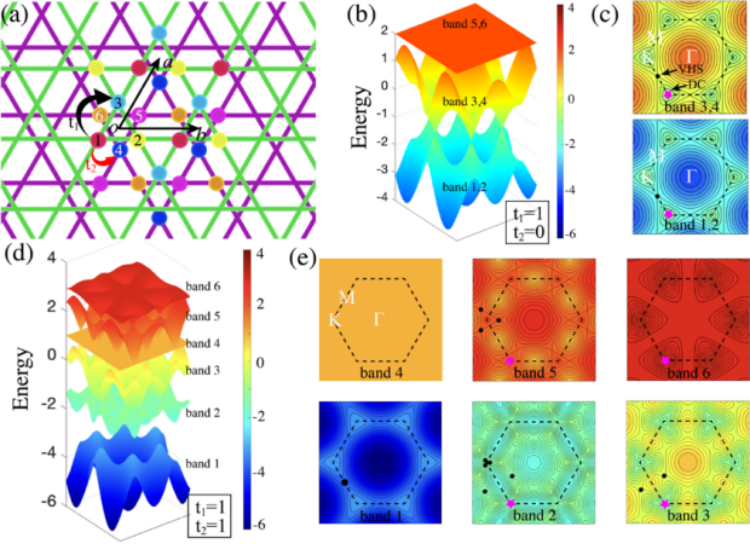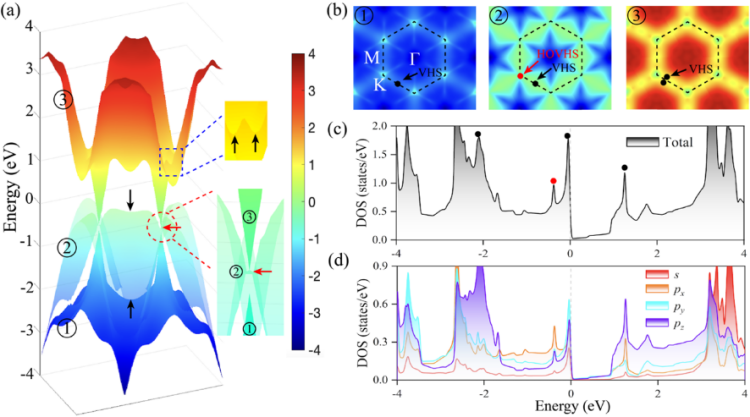NKU Team Makes New Progress in Low-dimensional Nanoelectronic Functional Materials
In the latest piece of research, Professor Hu, Zhenpeng's team from Nankai University proposed a new material, namely, bilayer Kagome borophene (BK-boropnene), which exhibits both traditional and higher-order van Hove singularities near the Fermi level with a Fermi velocity surpassing even that of graphene. This structure will provide a new platform for researches in quantum material systems and other fields. The relevant paper was published in Advanced Science, a famous international journal.
The Kagome lattice has a 2-dimensional structure composed of equilateral triangles, which exhibits characteristics such as van Hove singularities, flat bands, and Dirac bands, as well as an important potential in exploring new materials and quantum effects. Therefore, finding materials with stable Kagome lattices has become an important goal for scientists. As early as 2017, the team worked with experimental collaborators to generate electronic Kagome lattices by utilization of the twisted bilayer silicene, resulting in a topological non-trivial flat band structure (Sci. Adv. 2018, 4, eaau4511). In recent work, the team independently designed a series of new lattice structures based on the concept of symmetry breaking (Carbon Trends 2023, 11, 100256; Chin. Chem. Lett. 2022, 33, 3941; Front. Phys. 2022, 17, 63505), and worked with experimental collaborators to propose a scheme to regulate the electronic properties of low-dimensional materials (Small 2023, 19,2302192; ACS Nano 2022,16,13014). On this basis, the team designed a new type of lattice by rotating the bilayer Kagome lattice by 60 degrees. By regulating the interlayer coupling strength, the transition from traditional van Hove singularities to higher-order ones can be achieved in the tight binding approximation (TBA) model (Figure 1). Introducing boron atoms into this lattice, the team further proposed a new material (BK-boropnene) by performing comprehensive first-principles calculations.

Figure 1. The regulation of electronic structure by bilayer Kagome lattice and interlayer coupling.
BK-boropnene has attracted great attention, because it simultaneously features traditional and high-order van Hove singularities near the Fermi level. Compared to traditional van Hove singularities, higher-order ones have stronger divergence and can promote the formation of complex quantum phases, thereby triggering a series of interesting electronic phenomena. In BK-boropnene, higher-order van Hove singularities not only are in the same band with traditional ones, but also happen to be in the Dirac-like band, thus possibly capturing the complex correlated effects (Figure 2). This allows scientists to make in-depth investigations on these singularities in order to reveal novel electronic phenomena. For example, electronic states can be modulated to investigate and understand the superconducting properties. In addition, the Fermi velocity in BK-boropnene reaches up to 1.3 x 106 m/s, surpassing that of graphene, indicating its extraordinary potential in electron transport. This unique material is entirely formed through three-center two-electron (3c-2e) σ bonds, displaying remarkable stability in all dimensions, including energetic, dynamic, thermodynamic, and mechanical stability, further expanding the prospects for its applications. This discovery opens up new perspectives for the study of quantum materials. BK-boropnene with unique electronic properties, including ultra-high Fermi velocity and coexistence of traditional and high-order van Hove singularities, may pave a way for future breakthroughs in the fields of superconductivity, charge density waves, ferromagnetism, etc.

Figure 2. Electronic structure and van Hove singularities of BK-boropnenee (the black arrow represents traditional van Hove singularities, and the red arrow represents higher-order van Hove singularities).
Nankai University is the first affiliation of this work for accomplishing and corresponding. Postdoctoral fellow Gao, Qian from Nankai University is the first author, and Professor Hu, Zhenpeng is the corresponding author.
Link:
https://onlinelibrary.wiley.com/doi/10.1002/advs.202305059
(Edited and translated by Nankai News Team.)









